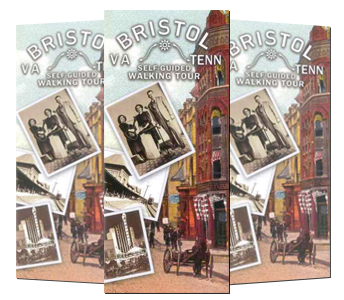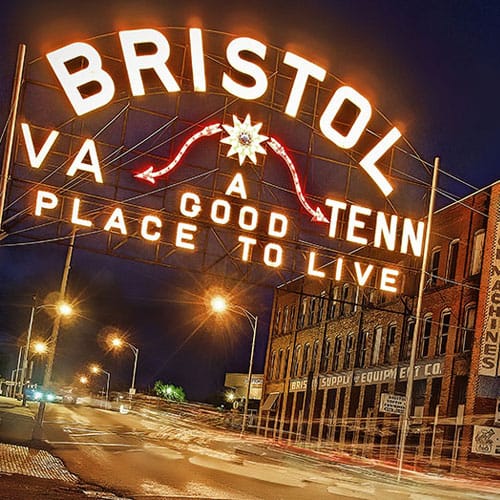 Any story of Bristol would be incomplete without addressing the age-old issue of the liquor industry. More than a 100 years ago, in 1909, Bristol Virginia faced what has been considered the most noted contested local election in the history of the city. This campaign captured the attention of both states and was significant for communities throughout the nation.
Any story of Bristol would be incomplete without addressing the age-old issue of the liquor industry. More than a 100 years ago, in 1909, Bristol Virginia faced what has been considered the most noted contested local election in the history of the city. This campaign captured the attention of both states and was significant for communities throughout the nation.
In 1909 both Bristol’s were dry following very contentious liquor referendums in May and November of 1907. This prohibition mantra was not a local trend, for within two years of 1907 larger and smaller cities throughout the nation, such as Worcester, Mass, Atlanta, Memphis, Knoxville and Johnson City, went dry. By 1909 the Georgia Legislature imposed prohibition throughout the state and Tennessee was within months of passing a statewide prohibition of liquor.
In the spring of 1909 petitions were being circulated throughout the streets of Bristol, Va., to bring the matter of liquor back to a vote. By the time it was noted in the local newspapers, the solicitors had confidence that they had more than enough to call for a vote. By town ordinance they had to gather equal to 20% of those that voted in the previous election, which totaled 160 people. On June 2 of that year 275 petitions were delivered and filed in the office of John H. Gose, clerk of the Corporation Court. The next day Judge Price verified the petitions and called for a town election on July 8. Members of the pro-liquor movement in the city made the claim that the city should take advantage of their sister city going dry in order to attract the wholesale and retail industry that will bring large taxes to the city and bring prosperity.
Immediately, the local Christian Women’s Temperance Union (CWTU) fired the first shot by organizing a meeting the following day to counter claims and draw support from the women of the city. Also, some of the signers cried “foul” stating that they were deceived into signing the petition and vowing that they would not vote for liquor during the election. Others admitted that they believed in prohibition, but wanted to allow it to come to a vote.
Within days people began ringing their hands as sides were being drawn. It was commonly thought that the “wets” could not overcome the decisive majority from the last election, but not wanting to be lulled to sleep, Temperance leaders of the city organized quickly. Within weeks Temperance leaders from across the East Coast descended on Bristol and impressed both sides about the significance of the pending election. The prohibition movement was making huge strides throughout the United States, but they could not afford to back-up in the region. By July 1, 1909 every saloon and mail-order house in Lafollette, Nashville, Chattanooga and Memphis would close its doors, which would make Tennessee dry from Bristol in the East to the Mississippi in the West. This was the most far reaching bill produced to date by the Tennessee legislature.
In Virginia the battle was fierce. Prohibition advocates criticized the government of Washington & Jefferson and thought of them as being in the pocket of the liquor industry. Petersburg, which was dry, reverted back to saloons in previous months and locally the Abingdon dispensaries were counted as some of the most ardent liquor supporters. The Bristol, Va. election was essential to prohibition, which would help restrict the flow of liquor across the street into Tennessee and keep the rising tide in balance favoring prohibition.
The day of the election came, drawing spectators from every section of both states. The hotels of both cities were full, drawing their own spectators from the citizenry. Representatives from the liquor industry, now displaced in Chattanooga and other Tennessee cities, were sizing up the territory in the event the measure would pass. Both sides expressed confidence in the outcome to the largest ground swell of citizen involvement in the history of the town. There was very little violence, which was credited to the abolition of the drink two years earlier, but a contest that covered every inch of ground, educationally and politically.
The polls opened at sunrise and closed at sunset with the announcement on the floor of the Bristol Virginia Courthouse at 9:15 p.m. The town had gone wet by a majority of only 32 votes. In the view of the prohibitionists, the town went silent, with pro-liquor advocates, hundreds of them shouting in the streets, celebrating for over an hour, according to city leaders.
As a result of the election, dozens of saloons and mail order houses reopened in the city within months. The demand for retail space and storage was especially overwhelming to an already established construction boom in the city.
The Bristol, Va. election assured that Bristol, Tenn. prohibition would fall in November 1909. Bristol, Virginia-Tennessee, which was the primary business center between Roanoke and Knoxville, also remained the regional center of the liquor industry until liquor was prohibited nationally in 1916.





 It is fitting that two of the most famous things about Bristol should be celebrated by neighboring murals, here on either side of State Street. The first is a tribute to NASCAR and two of its greatest legends, Dale Earnhardt Sr. and Richard Petty, both of whom were successful at world famous Bristol Motor Speedway.
It is fitting that two of the most famous things about Bristol should be celebrated by neighboring murals, here on either side of State Street. The first is a tribute to NASCAR and two of its greatest legends, Dale Earnhardt Sr. and Richard Petty, both of whom were successful at world famous Bristol Motor Speedway. Commemorating the historic 1927 Bristol Sessions, this striking music mural was painted by local artist and musician Tim White in 1987. Featuring Ralph Peer, who organized those momentous recording sessions, as well as some of the most well known artists from them, like The Carter Family, The Stoneman Family and Jimmie Rodgers, the mural is a tribute to Bristol’s expansive musical heritage.
Commemorating the historic 1927 Bristol Sessions, this striking music mural was painted by local artist and musician Tim White in 1987. Featuring Ralph Peer, who organized those momentous recording sessions, as well as some of the most well known artists from them, like The Carter Family, The Stoneman Family and Jimmie Rodgers, the mural is a tribute to Bristol’s expansive musical heritage. The arrival of the railroad in 1856 led to the founding of Bristol. By the mid to late 1800s Bristol had become the largest center for commerce and industry between Roanoke, Va. and Knoxville Tenn., a 100-mile radius from where you are now.
The arrival of the railroad in 1856 led to the founding of Bristol. By the mid to late 1800s Bristol had become the largest center for commerce and industry between Roanoke, Va. and Knoxville Tenn., a 100-mile radius from where you are now. Coinciding with the golden age of Hollywood, this majestic movie palace was built in 1931 – a masterpiece of art deco craft, blessed with an opulent, richly embellished interior, plush seats and a stunning array of Venetian style murals.
Coinciding with the golden age of Hollywood, this majestic movie palace was built in 1931 – a masterpiece of art deco craft, blessed with an opulent, richly embellished interior, plush seats and a stunning array of Venetian style murals. Over 10 hot days in the summer of 1927, on this very spot, in a dark curtained room with blankets on the wall above an old hat warehouse, a 35-year-old Kansas-raised New Yorker by the name of Ralph Peer invented country music…
Over 10 hot days in the summer of 1927, on this very spot, in a dark curtained room with blankets on the wall above an old hat warehouse, a 35-year-old Kansas-raised New Yorker by the name of Ralph Peer invented country music… Although this landmark electric sign is viewed fondly by locals, it has actually had a checkered history. The sign was donated to the cities by the Bristol Gas and Electric Company and erected in 1910. It was originally located on the corner of Third and State Street (on top of the Bristol Supply & Equipment Company building) which is to the right of the sign’s current position. Back then, it read ‘Push! That’s Bristol’ instead of a “A Good Place to Live”.
Although this landmark electric sign is viewed fondly by locals, it has actually had a checkered history. The sign was donated to the cities by the Bristol Gas and Electric Company and erected in 1910. It was originally located on the corner of Third and State Street (on top of the Bristol Supply & Equipment Company building) which is to the right of the sign’s current position. Back then, it read ‘Push! That’s Bristol’ instead of a “A Good Place to Live”. Bristol Train Station
Bristol Train Station Any story of Bristol would be incomplete without addressing the age-old issue of the liquor industry. More than a 100 years ago, in 1909, Bristol Virginia faced what has been considered the most noted contested local election in the history of the city. This campaign captured the attention of both states and was significant for communities throughout the nation.
Any story of Bristol would be incomplete without addressing the age-old issue of the liquor industry. More than a 100 years ago, in 1909, Bristol Virginia faced what has been considered the most noted contested local election in the history of the city. This campaign captured the attention of both states and was significant for communities throughout the nation. Located in Bristol were WCYB’s radio program and later television programming, with coverage in five states – Tennessee, North Carolina, Virginia, West Virginia and Kentucky.
Located in Bristol were WCYB’s radio program and later television programming, with coverage in five states – Tennessee, North Carolina, Virginia, West Virginia and Kentucky. Located on the site of the old Bristol, Va. Courthouse, this peaceful and respectful setting honors all of the nation’s war veterans. The five life-size bronze sculptures that pay tribute to our servicemen and women are the main focus, but there is also a Cobra AH-1F combat helicopter on display, as well as an eternal flame symbolizing the fight for freedom.
Located on the site of the old Bristol, Va. Courthouse, this peaceful and respectful setting honors all of the nation’s war veterans. The five life-size bronze sculptures that pay tribute to our servicemen and women are the main focus, but there is also a Cobra AH-1F combat helicopter on display, as well as an eternal flame symbolizing the fight for freedom. Bristol’s reputation as a mecca for music was launched in 1927, along with the careers of musical legends the Carter Family, Jimmie Rodgers and others, in what has been lauded the “Big Bang” of country music — the historic Bristol Sessions.
Bristol’s reputation as a mecca for music was launched in 1927, along with the careers of musical legends the Carter Family, Jimmie Rodgers and others, in what has been lauded the “Big Bang” of country music — the historic Bristol Sessions. Hank Williams is widely acknowledged as one of country music’s greatest songwriters. His number one hits include “Cold, Cold Heart,” “Your Cheatin’ Heart,” “Hey Good Lookin’,” and “Lost Highway”.
Hank Williams is widely acknowledged as one of country music’s greatest songwriters. His number one hits include “Cold, Cold Heart,” “Your Cheatin’ Heart,” “Hey Good Lookin’,” and “Lost Highway”.

